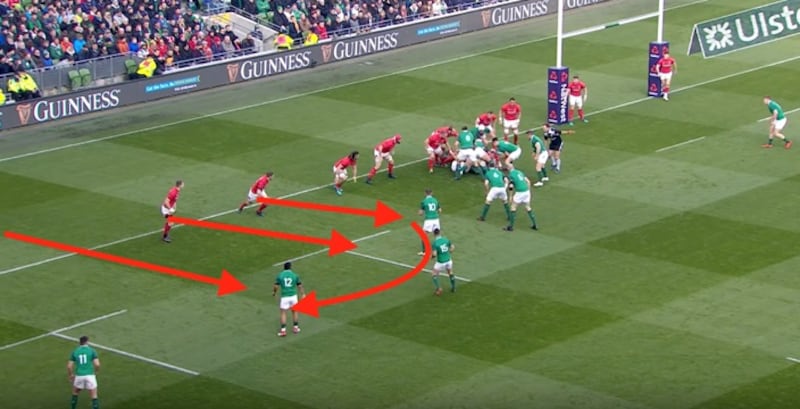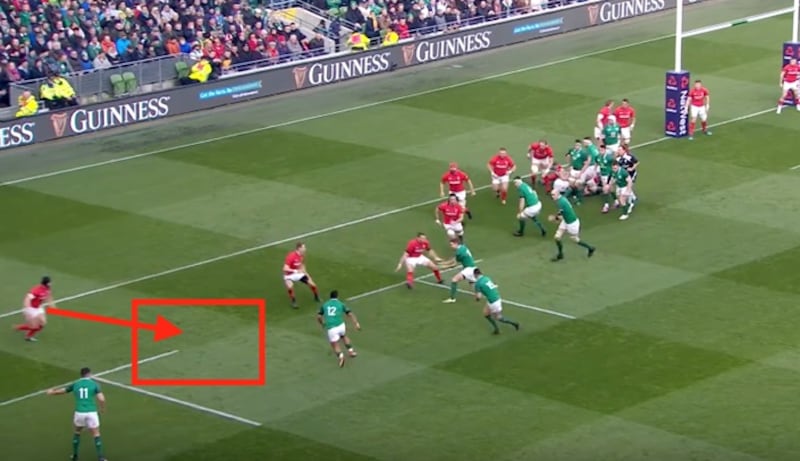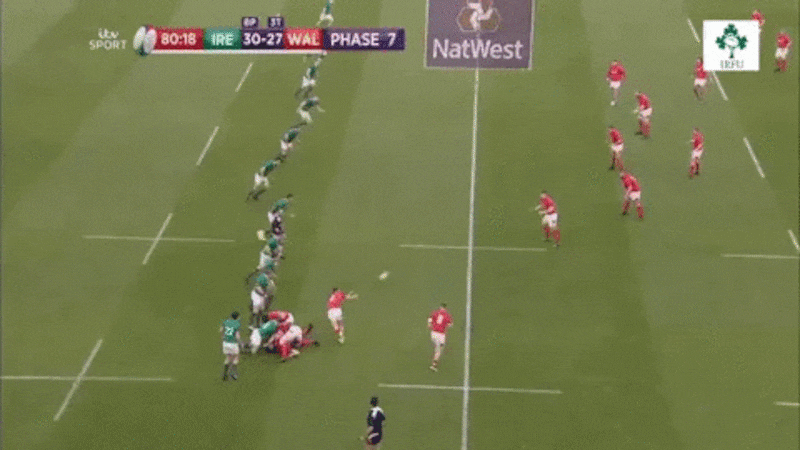Does anyone remember a 22-year-old Tadhg Furlong at the 2015 World Cup? He made his debut in the August warm-ups – we met in the departure lounge – only coming off the bench against Romania.
Tadhg probably could have delivered if exposed to Test match rugby a little sooner.
Hindsight is wonderful.
As a squad-building exercise, the 2018 Six Nations has already proved of enormous value. After Andrew Porter was forced into playing 76 minutes against Italy, the recently converted tight-head showed up for 66 minutes of Saturday's victory over Wales.
That's one example of Joe Schmidt and Ireland addressing a glaring problem within the current four-year cycle. Those who were parachuted into the team to face Argentina in the 2015 quarter-final were quality players but not enough of them had not played enough Test matches that really mattered.
It’s conceivable that Porter, Chris Farrell, Bundee Aki and Dan Leavy will not make the starting XV come the 2019 World Cup quarter-final but they will be established internationals with valuable experience.
That means a seemingly permanent Irish rugby problem – under the catch-all of ‘strength-in-depth’ – will have been addressed.
Flip it over. Selecting Farrell, Aki and Leavy would mean Garry Ringrose, Robbie Henshaw, Seánie O'Brien and Josh van der Flier are not on the field. Almost half those men will be injured at any one time – see Ringrose for Farrell next week – but look at the options.
That's the value of the 2018 Six Nations. Exposure.
If the Grand Slam or Championship follows, well, happy days are here again.
Porter and James Ryan have been key figures in games that really matter. Remarkably, Porter held his own against the Italian and Welsh scrums while Ryan was excellent in Paris and again last weekend.
Leavy has also laid down a marker while Jacob Stockdale’s try-scoring smiles tell us he’s having the time of his life.
Now, we are still three key injuries – which we know can happen – away from not achieving our primary goal in the Schmidt era (to go where no Irish team has been before) but I’d like to hear an argument against his bravery of selection and – after Saturday’s five tries – Ireland’s attaching strategy.
Communication lines
I heard and read plenty of criticism after victory over France in Paris. It’s easy to be critical without a solution. Anyone can do that.
I’m hearing lots of – ‘ why are we doing that’?
Not much – ‘ we need to do this...’
I presume this feeds into the IRFU reducing media access to the coach and his players. There are many perspectives on this, but history isn’t kind to such a strategy.
The media remain an integral part of our sport, providing both biased and unbiased opinions. Our game is still growing, as a professional entity, with more and more people seeking thought-provoking insight but rarely can this come from the institution generating the topic of discussion.
Trying to control the flow of information might seem important when you live and breathe a game of tiny margins. That’s the understandable perspective from within “the bubble”. However, every scrap of this information does not hold the same value but if it is all safeguarded then it creates a disconnect with some of the stakeholders – namely the punters. In reality, an insight into the life or opinion of a player is valuable only to the interested person reading an article.
The opposition do not really care.
Eddie Jones, Michael Cheika, Steve Hansen and Warren Gatland – even after being painted up as a clown on page one of the national newspaper of his own country – understand the need to keep communication lines open.
Sing when you’re winning. Because, when you slice through the din, the value of independent feedback can be a boon for Ireland on this arduous road to Japan.
Otherwise, confirmation bias might set in. Some of us lived through that at the 2007 World Cup.
Remember the big picture; look into our crystal ball and see Ireland embroiled in a vicious arm-wrestle with the Springboks – after Rassie Erasmus gets their house in order and fields the biggest pack the game has ever see – at Tokyo’s Ajinomoto Stadium on October 20th 2019 (presuming we beat the Scots!). Imagine how good Furlong and Ringrose can become by then but what if both are forced off after 30 minutes?
England's game is built upon doing the fundamentals exceptionally well but what keeps them firmly second to the All Blacks' No1 world ranking is an inability to problem-solve on the pitch
Imagine Porter and Farrell coming on (or vice versa depending on form and fitness over the next 18 months – yes, it can be that virtuous a loop we are about to enter).
After last weekend that is no longer a worry. Considering all the injuries that every squad is suffering, at least Ireland are uncovering solutions. Proof is in the individual performances we are witnessing from Porter, Farrell and Ryan. Their arrival on the scene is timely and hugely encouraging.
(Considering it is still only the opening chapter of their stories, which will present many difficult moments, the simplistic transference of Paul O’Connell’s career path onto James Ryan is, as Ryan rightly said “inappropriate”. It’s unnecessary pressure on a 21-year-old. I’d prefer to enjoy these young lads for what they are doing right now.)
Breakdown work
I will constructively examine Ireland’s wide defence but let’s get through the wealth of positives beforehand, starting with some incredibly efficient breakdown work.
Scotland absolutely pulverised England in the Murrayfield tackle zones. For some of their 13 turnovers, English players arrived at the ruck 1.5 seconds behind Scottish flankers.
That’s unacceptable at any level of rugby.
(I’ll dedicate next week’s column to Scottish work at the breakdown because that will be the game and perhaps where the Championship will be won or lost.) England’s game is built upon doing the fundamentals exceptionally well but what keeps them firmly second to the All Blacks' No1 world ranking is an inability to problem-solve on the pitch.
They have the strike runners – Jonny May, Jonathan Joseph and Anthony Watson – along with playmakers in Owen Farrell and George Ford to beat any team but their failure to breach the gainline, Nathan Hughes did not do his job against Scotland, or secure enough of primary ball served to largely nullify these strengths.
Eddie Jones got the backrow balance wrong. Injuries have not helped. They badly miss Billy Vunipola.
That’s what makes Irish performances of late so impressive. They have won 10 straight Test matches since my old mate Jamie Heaslip was forced off the scene (see you on the other side, Jamie) and after losing O’Brien then van der Flier we were really digging into the backrow reserves.
Ireland are not better without Heaslip and O’Brien but the Leavy, Peter O’Mahony, CJ Stander backrow, while not perfectly balanced, has been damn effective.
Scotland will test that.
England must fix their breakdown and ball-carrying in Paris, or they will lose again, so we can expect the full force of that backlash come March 17th at Twickenham.
Still, Ireland’s breakdown work, the speed and low body shape, has been as good as I’ve ever seen it. Josh Navidi and Aaron Shingler earned their Welsh jerseys based on turnovers as much as anything else. Neither flanker featured over the ball in Dublin.
Ireland’s attack has clearly evolved. It is not a case of keep the ball and wait for the opposition to wilt. No, they go through phases constantly searching for an opportunity. They sensed Wales had a soft underbelly – see the Cian Healy and Leavy tries – but after going through the guts they knew when to launch Keith Earls out wide.
Ireland can score both ways.
Complex rugby
My favourite moment from Saturday was Jacob Stockdale’s first try. It’s a passing drill – four attackers against three defenders – rugby players have been doing forever.
Ireland have the finished article in Sexton with one or two almost there, while England struggle in this regard
We used to do it on a loop; groups of four, flat out for 30-60 seconds, with fatigue forcing behaviour to become subconscious.
Teenagers do it every day in schools and clubs around the country. How many of them will be trying the Johnny Sexton pass this week? How many will be able to pull it off?
It’s a pass that will inspire the next generation.
Wales are numbered up with Dan Biggar on Johnny, Liam Williams on Rob Kearney and Leigh Halfpenny covering Aki as Stockdale hugs the touchline.

Normally what happens is the first receiver feeds the second man (Kearney) who picks his pass – a skip to Stockdale or pop to Bundee – just before contact. Aki and Kearney run a ‘Rugby League-line’ so Halfpenny has eyes on Kearney’s run with a view to taking man and ball.

The two steps Halfpenny takes into the space, as Sexton releases, are where a defender should hedge his bets to shut Kearney down.
It did not matter. Johnny performs the spectacular – putting the ball where Halfpenny did not believe he could – so Stockdale goes over in the corner.

It’s phenomenal play.
This is complex rugby but Ireland patiently wait for these opportunities. They don’t force it. That’s the value of decision-makers who can problem-solve on the pitch. Ireland have the finished article in Sexton with one or two almost there while England struggle in this regard.
Unfortunately, all this can and probably will be fixed.
Ireland also have to solve problems with their defence showing space out wide to the opposition from turnovers. Italy and Wales have late tries to prove it. Exhaustion is a factor. Maybe there are questionable defensive reads by the wide defenders but that’s too simplistic an area of pointed blame.
It stems from within. Andy Farrell’s defence tempts the attack to go for those over the top passes in a fight for the space. Ireland got caught badly for the Navidi and Stef Evans tries so presumably Scotland are looking at this and thinking: let’s open them up the same way we did England.
Finn Russell will put kicks through or throw the long pass for Huw Jones, who picks clever lines, off multi-phase attacks.
Ireland will show them this space. The scramble defence needs calm heads readied for the danger; you defend the space where they will attack.
It’s a work in progress.
You want to see players react and recover from mistakes on the pitch.
It's important that Jacob Stockdale went for the intercept that delivered his eighth try in seven internationals regardless of the scoreboard or clock.

Dominate over the ball – especially in transition – and this problem is stifled at source but that’s another column in itself.















